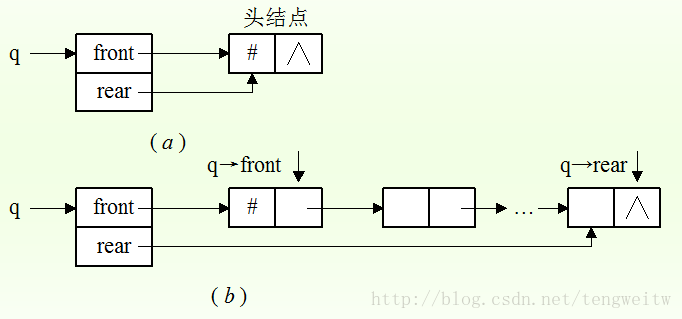链表队列很简单,之前看到过,没有用程序实现。其原理就是遵循FIFO原则,只能从队首取元素,从队尾插入元素,就和排队模型一样。因此只需要队首指针和队尾指针就可以方便的进行队列操作。因为在最近看的图论算法中,经常用到队列,在这里就先用程序实现链表队列。
和单链表一样,为了运算方便,我们也在队头节点前附加一个头结点,且头指针指向头结点。其链表队列的示意图如下:

下面是具体的程序实现:
1
2
3
4
5
6
7
8
9
10
11
12
13
14
15
16
17
18
19
20
21
22
23
24
25
26
27
28
29
30
31
32
33
34
35
36
37
38
39
40
41
42
43
44
45
46
47
48
49
50
51
52
53
54
55
56
57
58
59
60
61
62
63
64
65
66
67
68
69
70
71
72
73
74
75
76
77
78
79
80
81
82
83
84
85
86
87
88
89
90
91
92
| #include<stdio.h>
#include<stdlib.h>
typedef struct node//定义节点的结构体
{
int data;
struct node *next;
}linklist;
typedef struct//定义链表
{
linklist *front,*rear;
}linkqueue;
void SetNull(linkqueue *q)
{
q->front=(linklist *)malloc(sizeof(linklist));
q->front->next=NULL;
q->rear=q->front;
}
int Empty(linkqueue *q)
{
if(q->front==q->rear)
return 1;
else
return 0;
}
int Front(linkqueue *q)
{
if(Empty(q))
{
printf("queue is empty!");
return -1;
}
else
return q->front->next->data;
}
void ENqueue(linkqueue *q,int x)
{
linklist * newnode=(linklist *)malloc(sizeof(linklist));
q->rear->next=newnode;
q->rear=newnode;
q->rear->data=x;
q->rear->next=NULL;
}
int DEqueue(linkqueue *q)
{
int temp;
linklist *s;
if(Empty(q))
{
printf("queue is empty!");
return -1;
}
else
{
s=q->front->next;
if(s->next==NULL)
{
q->front->next=NULL;
q->rear=q->front;
}
else
q->front->next=s->next;
temp=s->data;
return temp;
}
}
void main()
{
linkqueue q;
SetNull(&q);
ENqueue(&q,2);
ENqueue(&q,3);
ENqueue(&q,4);
DEqueue(&q);
DEqueue(&q);
int a=0;
a=Front(&q);
printf("%d\n",a);
}
|



